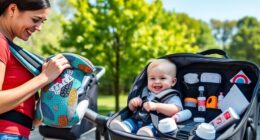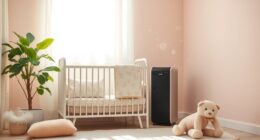To safeguard your baby from the hidden risks of secondhand smoke, you should create a smoke-free environment at home and avoid places where smoking occurs around your child. Supporting stronger smoke-free laws and quitting smoking yourself can make a big difference. Regularly cleaning your home and encouraging friends and family to respect your rules also helps reduce exposure. Keep learning about effective strategies to shield your little one from these dangers and ensure their healthy start.
Key Takeaways
- Secondhand smoke increases risks of SIDS, asthma, ear infections, and respiratory illnesses in infants.
- Creating a smoke-free home environment minimizes infants’ exposure to harmful chemicals.
- Supporting strong tobacco laws in public and private spaces helps protect children from secondhand smoke.
- Quitting smoking reduces toxins in the household, promoting a healthier environment for your baby.
- Community involvement and policies are essential to safeguard infants from hidden secondhand smoke risks.

Secondhand smoke is not just unpleasant; it poses serious health risks to everyone exposed. As a parent or caregiver, your priority is to make certain your baby’s safety and well-being. Exposure to secondhand smoke can lead to a host of health issues in infants, including sudden infant death syndrome (SIDS), asthma, respiratory infections, and ear infections. Because babies breathe more rapidly and their immune systems are still developing, they are especially vulnerable to the harmful chemicals in tobacco smoke. Protecting your child means understanding the dangers and taking active steps to minimize their exposure.
Secondhand smoke endangers infants with SIDS, asthma, and infections due to their vulnerable, developing immune systems.
One effective way to shield your baby from secondhand smoke is by advocating for stronger tobacco legislation. These laws are designed to limit smoking in public places, workplaces, and in some cases, private homes or vehicles when children are present. When you support tobacco legislation that enforces smoke-free environments, you’re helping reduce the overall presence of harmful chemicals in the air your child breathes. Stronger laws not only protect your family but also contribute to broader public health efforts to decrease smoking rates. You can participate in community initiatives, contact your representatives, and support policies that promote smoke-free zones, especially in areas frequented by children.
In addition to supporting tobacco legislation, prioritizing smoking cessation is essential. If you or someone in your household smokes, quitting is the single most impactful step you can take to protect your baby. Quitting reduces the risk of exposing your child to harmful toxins and creates a healthier environment at home. There are many resources available to help with smoking cessation, from counseling programs and support groups to nicotine replacement therapies. Remember, quitting isn’t easy, but the benefits for your child’s health are immeasurable. By making the effort to stop smoking, you’re not only improving your health but also setting a positive example for your family and community. Additionally, using essential oils for respiratory health can support your efforts by promoting clearer breathing and relaxation as you work towards quitting.
Creating a smoke-free home environment is vital. Make your home a designated no-smoking zone and encourage friends and family to respect this rule. When you’re outside, choose smoke-free areas and avoid places where smoking is permitted around children. Your proactive approach can markedly reduce your baby’s exposure to secondhand smoke, giving them a healthier start in life. Ultimately, protecting your baby from these hidden risks requires a combination of personal effort, community involvement, and support for policies that promote smoke-free environments. Your actions can make a profound difference in safeguarding your child’s future.
Frequently Asked Questions
Can Secondhand Smoke Affect My Unborn Baby’s Development?
Secondhand smoke can considerably impact your unborn baby’s development. When you’re exposed, it can interfere with prenatal development, increasing risks of low birth weight and preterm birth. This exposure also jeopardizes fetal health, potentially leading to long-term health issues. To protect your baby, avoid places with smoke and ask others not to smoke around you. Your actions directly influence your baby’s well-being and future health.
Are There Specific Times or Places More Dangerous for Exposure?
You should be especially cautious in public places and home environments where smoking occurs. These are the most dangerous times and places for exposure, as secondhand smoke can linger and affect your baby’s developing lungs. Avoid smoky environments whenever possible, and ask smokers to step outside. Protecting your baby means reducing exposure during these critical times, ensuring a healthier start in life.
How Can I Detect Hidden Tobacco Smoke Residues in My Home?
To detect hidden tobacco smoke residues in your home, focus on indoor air quality, which can reveal lingering smells and chemicals. Use a smoke test kit or an air quality monitor designed for tobacco smoke detection. If you notice odors or suspect residues, thoroughly clean surfaces and fabrics with residue cleaning products. Ventilate your home well, and consider professional cleaning if necessary to guarantee your space is safe for your baby.
What Are the Long-Term Health Effects on Infants Exposed to Secondhand Smoke?
You should know that infants exposed to secondhand smoke face long-term health risks, like impaired lung development and increased chances of respiratory infections. This exposure can hinder their lung growth, making them more prone to asthma and other breathing problems later in life. By avoiding smoke around your baby, you help protect their developing lungs and reduce their risk of serious respiratory illnesses, ensuring healthier growth and development.
Can Thirdhand Smoke Also Harm My Baby?
Imagine invisible shadows of danger lingering long after smoke disappears—that’s thirdhand residue. Yes, it can harm your baby by exposing them to chemical exposure from these residues on surfaces and clothes. Even if you think the air is clear, these hidden toxins can seep into your baby’s skin and tiny lungs, putting their fragile health at risk. Protect your little one by minimizing exposure to these unseen hazards.
Conclusion
Protecting your baby from secondhand smoke is like shielding a delicate flower from harsh storms—you want to create a safe, nurturing environment. By avoiding smoke exposure, you’re not just preventing immediate harm, but also planting seeds for healthier lungs and brighter futures. Remember, your choices today shape their tomorrow. Keep your home a sanctuary, free from hidden risks, and watch your little one thrive in the warmth of your care and love.









